A couple of lupins bought from Beaver Creek and planted this year - Lupinus wyethii (with this year's seedling Salvia pachyphylla in the background - if it survives and thrives, it may one day outgrow its spot... I don't think I'll worry about that just yet ;)) and Lupinus aridus ssp. ashlandensis, which has put up a couple of flower buds:
Comments
Re: Alpines September 2012
Cute little Lupines! I wonder if the second will get a chance to mature its flowers?
Re: Alpines September 2012
I like these little Lupines more than the huge Russel hybrids often grown in gardens here!
Re: Alpines September 2012
Now starting to open, Lupinus aridus ssp. ashlandensis, bought from Beaver Creek this spring: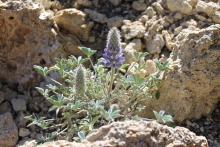
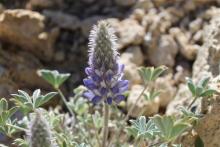
Attractive foliage on Goniolimon cf. speciosa, from seed last year (Holubec seed from China, Karlik Shan, Xijiang):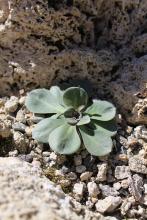
Erigeron nematophyllus, from seed last year, in bud now: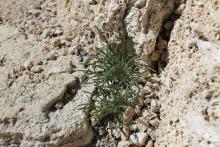
This year's seedlings of Astragalus loanus... one doing OK so far, the other not so well... very difficult to grow, according to Stephanie's article in the fall, 2011 RGQ, so this may well be the best look I get at them!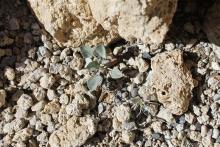
Seed heads of Agoseris glauca: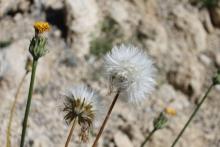
Two of this year's seedlings of Dracocephalum multicaule (seed from Pavelka: "2400m, Aras Dag, Turkey; dense cushions, erect leafy stems, 10-15cm, many white to pale yellow flws, stoney slopes"). One is a very attractive plant though with smaller flowers than the other, less dense, but larger-flowered one.
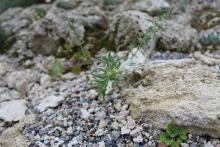
Re: Alpines September 2012
Lori, many gems but the lupin is the diamond - so far ;D
Re: Alpines September 2012
I got that Lupinus from Beaver Creek as well....didn't even live long enough to plant out! It seems to detest wet.
Some current bloomers:
Delphinium species (who knows which one!), Epilobium fleischeri, Erica cinerea 'Atropurpurea' and Gentiana asclepiadea
Re: Alpines September 2012
Some others: Salvia przewalskii (just starting), Gentiana loderi, G. veitchiorum and an out-of-season bloom on Pulsatilla turczaninovii.
Re: Alpines September 2012
Nice, Todd!
Here the fall rain has started and it is completely soaked everywhere :(
No flowers but here are some nice Saxes on my roof. Hope they flower next spring!
Re: Alpines September 2012
Impressive saxes Trond!
Re: Alpines September 2012
This is a real little treasure flowering for the first time, though it has grown vegetatively quite happily for several years, Gentiana depressa. Only one flower but somehow it commands attention. I am quite surprised this grows with us at all in our dry garden and expect I will now be told that it makes huge flowering mats all over Scottish gardens! This belongs to the same section as the rather legendary G. urnula, all nicely described and drawn in Josef Halda's monograph on Gentiana. I think I may be lucky to grow any more of them!
Re: Alpines September 2012
Viewed at full magnification, it's a giant among the dwarf leaves. The colors are so distinct, and no wonder people love gentians! :o
Re: Alpines September 2012
It's a beauty to be sure! And what a tubby little flower!
Not much happening here...
An update on Lupinus aridus ssp ashlandensis: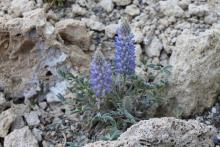
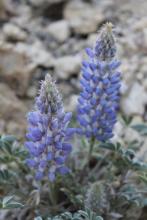
The colour of Scutellaria hypericifolia seems especially intense these days:
Re: Alpines September 2012
After I showed the flower of Gentiana depressa, Lesley Cox in New Zealand described a plant she grew with over 100 flowers, and a picture of another flowering freely (see the SRGC Forum). So it's back to the drawing board for me! It must be the fact that it has not flowered at all in our garden which makes even one flower so exciting.
Re: Alpines September 2012
Tim; I think you do well just to have G. depressa. Rick Lupp (Mt. Tahoma Nursery) offered it years ago, the only time I've seen it offered in the US. I was unable to keep it going. Your post offers hope that it is possible and worth trying again!
Re: Alpines September 2012
Indeed. I never have regrets showing my obviously "less than stellar" plant forays, like all those tiny frit bulbs :rolleyes:. It's all a learning process that may or may not happen. I wish these forums' members would volunteer more cultural information, rather than just pretty pictures. (Although, I do love the pretty pictures!) In my view, NARGS is a little better at this than the SRGC.
Re: Alpines September 2012
Don't go back to the drawing board Tim . You are doing a brilliant job and I enjoy seeing what you grow
Re: Alpines September 2012
Tim, to put all this in perspective, you probably have one of the best examples of G. depressa in England at the moment.
Re: Alpines September 2012
I wish these forums' members would volunteer more cultural information, rather than just pretty pictures.
It is said that a picture can be worth a thousand words!
Re: Alpines September 2012
Hmm.. kind of a blue theme in these late summer ( I was going to say fall, but I guess for most of you it's still summer!) flowers!
Re: Alpines September 2012
I do agree with Rick - that steady detail of how you go about making a bed and planting it does make you focus more closely on how you are growing the plants. I particularly like it when plants begin to seed naturally and intermingle because you begin to really get what goes on in Nature, even if it is only on a tiny scale. Edraianthus pumilio has been a real star seeding around on the sand bed (and could almost be mistaken for Eritrichium howardii in autumn plumage!). The success of this sand bed is encouraging us to develop other, and different, areas for growing alpines, and the prospect of removing an ugly leyland conifer hedge on the shady side of the garden which would open up a place for a different range of plants.
Re: Alpines September 2012
This is another fortuitous combination that works rather brilliantly - Cyclamen intaminatum and Artemisia schmidtiana 'Nana'. The cyclamen is seeding all over the raised bed and needs a place like this to show off its tiny intricately veined flowers. The artemisia is one of those plants that looks exceedingly sorry for itself over winter, but shines again the following year.
Re: Alpines September 2012
After I showed the flower of Gentiana depressa, Lesley Cox in New Zealand described a plant she grew with over 100 flowers, and a picture of another flowering freely (see the SRGC Forum). So it's back to the drawing board for me! It must be the fact that it has not flowered at all in our garden which makes even one flower so exciting.
Sometimes you can enjoy just one flower more than a carpet of them! The beauty of the flower drowns in the mass.
Re: Alpines September 2012
Tim, your sand bed is impressive even just in leaf! You have probably told us elsewhere and I have forgotten, but how do you feed the plants?
Re: Alpines September 2012
Tim, your gardens are a constant inspiration... and source of plant envy! ;D With every posting, there is a new bunch of species I have to put on my "get" list. It is very interesting and encouraging to see your young Gentiana depressa, and even more encouraging to see Lesley's extraordinary mature plant - so nice to see that it can be growable!
Nothing new here - Pyrethrum leontopodium is becoming woolier and woolier: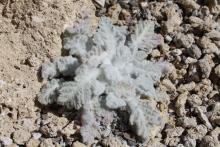
First blooms on Erigeron nematophyllus, from seed last year: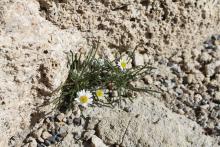
Orostachys iwarenge - it is so late-blooming that these inflorescences tend to get nipped in the bud (ha, a pun! :rolleyes:) by frost: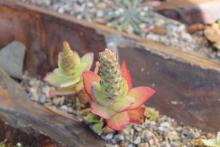
Re: Alpines September 2012
As always, Tim- a lot of great textures and colours there! Love the Cyclamen coming through the Artemisia! That might be a combination worth emulating, with different species of course!
Lori, the Pyrethrum seems to have the right idea! I think the mild frosts we've had are a good thing for the plants- a couple years ago we had no cold at all through Sept, then suddenly -20C in the first week of Oct, and it was very hard on plants, even native trees were caught off guard, with leaves unchanged frozen in place! This year in spite of the lovely days, there's been enough cold to get them preparing for winter..
Good to see the Orostachys surviving for you, even if the flowers don't make it... I have a couple of cuttings received in August outside - they seem to have new tight little growths in the centres, so they seem to be readying for winter, we'll see if they are hardy enough- I kept one piece inside!
I have first time buds on a couple of Townsendia parryi planted out last fall.. wonder if those buds will open?
Re: Alpines September 2012
Several people have asked about feeding plants on the sand bed and so far I haven't done this though I am sure some would have benefited. The idea of using sand is to limit the vigour of the plants, so in general those things that don't do so well I shall probably try in a richer 'scree' (yet to be constructed!). Many plants I am sure steadily get their roots down into the soil below and then begin to grow more vigorously. There are a few things that have stood still for ages which I really should have given a local feeding just to get them rooting out into the sand. Few plants really give signs of nutrient deficiency, but a couple of douglasias look very sad for themselves and small phloxes haven't done so well - the sand is probably just too deep. My dream would be a combined sand and tufa bed - the latter gives so many opportunities with more choice plants.
To put this in perspective though, here are a couple of pictures of alpines at Blackthorn Nursery, grown just in shallow gravel over the ordinary soil, and at Capt. Peter Erskine's garden... if you could start over! (These two gardens are an incredible inspiration but really not many people grow alpines outside like this).
Re: Alpines September 2012
A couple of interesting gardens, Tim! How deep would you say the shallow gravel is? In the new rock gardens I've made, they are basically built up with sod and soil, rocks used on the edges for stability, shape and look, then the upper and outer layers are soil with gravel in varying proportions- I've tried to keep some areas with more soil, some ridges and pockets of mostly gravel, and other areas with more humus added- theoretically to suit different plants. One of my intentions is that the raised aspect of the beds and the gravel will provide for dry crowns for the plants, but the soil inside the mounds will be available to those with deeper roots that don't want to really dry out... time will tell if it works! So far the things I planted last year are mostly happy, though I don't know that any of them are fussy anyway- certainly not the semps that are the main part of one bed..
In the second garden, is this cut into natural rock, or more of a built up wall? or?
Re: Alpines September 2012
To put this in perspective though, here are a couple of pictures of alpines at Blackthorn Nursery, grown just in shallow gravel over the ordinary soil, and at Capt. Peter Erskine's garden... if you could start over! (These two gardens are an incredible inspiration but really not many people grow alpines outside like this).
. . . . .if I had space!
Thanks for the info regarding feeding. It is more or less what I assumed - but it is sand and sand you know. Some kinds are more nutrient rich than others and I believe some plants are more craving than others too!
Re: Alpines September 2012
Everyone's plants are just awesome! I especially like the Teucrium aroanum and Pyrethrum leontopodium. How exciting to have such beauties in the garden!
After seen Orostachys iwarenge again in Lori's and Michael's gardens, I am even more suspect of the identity of a seedling of same grown from the NARGS seed ex this year. And the bugger even decided to flower the first season! Any suggestions?
Re: Alpines September 2012
After seen Orostachys iwarenge again in Lori's and Michael's gardens, I am even more suspect of the identity of a seedling of same grown from the NARGS seed ex this year. And the bugger even decided to flower the first season! Any suggestions?
[attachthumb=3]
I dunno... looks like Orostachys iwarenge to me... could maybe use more light. Some of the ones I grew last year bloomed in the first season too.
Re: Alpines September 2012
Cohan - Peter Erskine's garden is what we all wish for, a steep slope up to the field above, good well drained greensand soil, moisture always percolating through because of the field above. All the rock and tufa is imported and the garden built into the slope (and it all had to be brought up from below past the house so a huge amount of work was involved). It's a great garden because of the strong discipline put on the range of plants grown - I for one want to grow far too many different plants requiring different conditions. I should put these pictures under a different topic since they were taken in May(!), but just to show some other views - you can never stop adding to a garden like this!
Re: Alpines September 2012
Looks like a delightful place to visit :) thanks for sharing more!
Re: Alpines September 2012
What a great garden, Tim. :o And no tree root competition, to boot!
About my orostachys, thanks Lori. I really don't know anything about the genus, and except for one plant I grew a decade ago (no clue as to species), I've not grown them before. Good to know that some of yours bloom the first year from seed, too. I had thought it very odd (another bad assumption), especially with my inattentive care.
Re: Alpines September 2012
What a great garden, Tim. :o And no tree root competition, to boot!
Agreed!











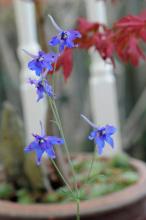
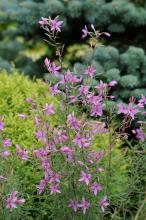
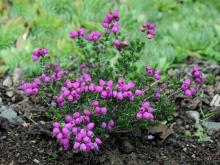
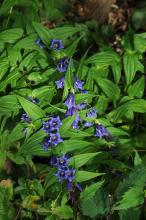
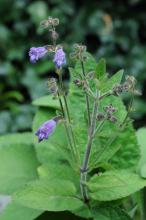
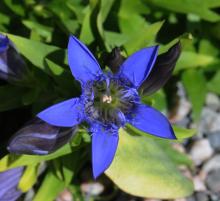
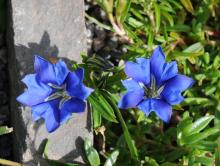
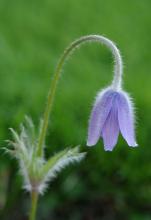
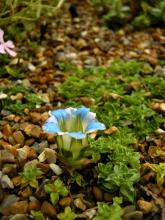



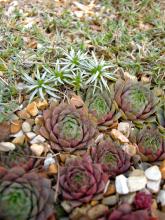
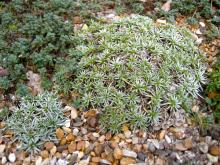
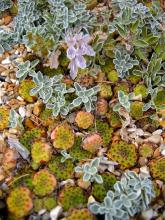
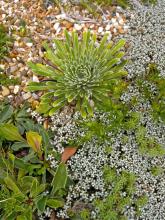
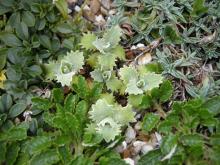
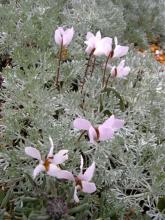
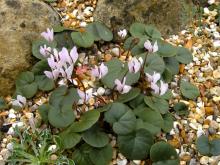
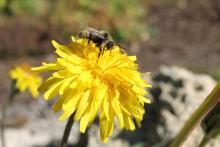




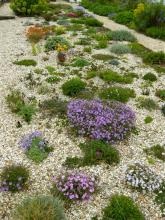
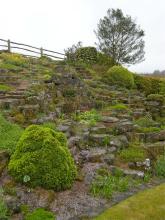

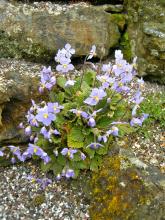
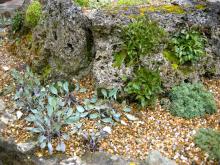

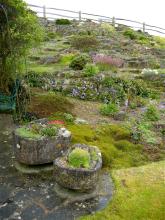
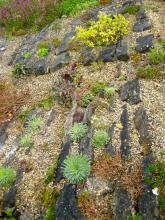
Those are extremely moreish plants Lori! I must try and emulate that coarse tufa scree. I have a few lupin species germinating and the bigger species like albifrons have made magnificent, if short lived, specimens in the garden.